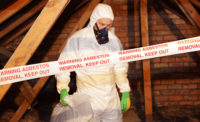Mold in a home is a serious matter that can cause not only substantial property damage but significant harm to an individual's health.
Any mold infestation requires immediate attention and cleanup, but it could be growing in a place that can't be seen and still affect one's health.
According to the Centers for Disease Control and Prevention (CDC), mold exposure can affect people in a range of ways, from nasal stuffiness and eye irritation to wheezing and skin irritation.
For those who are especially sensitive or who have a mold allergy, the reactions can be more severe.
Mold also can pose a higher health concern for those with asthma and other illnesses or compromised immune systems. Some research, including a study by the Institute of Medicine, also suggests that mold can cause respiratory illnesses in otherwise healthy people.
If an individual or his or her family members are exhibiting symptoms consistent with mold exposure that cannot be attributed to another illness, a mold problem in the home may be to blame. Mold can vary in appearance but it can be readily recognized by its white to greenish or black spotty appearance. There also can be a damp, musty odor in areas where mold is growing.
When mold is visible to the eye, it's easier to connect health concerns with the mold growth.
However, if an individual is not aware of any mold in his or her home, some additional investigating can be done.
Do-it-yourself kits can detect mold spores accumulating in household dust, including the types most associated with water damage and health issues.
Depending on the degree and type of mold discovered, the problem may be eradicated by a do-it-yourself clean-up. But if the growth is extensive, a trained professional such as an industrial hygienist may have to be hired to locate, eradicate and prevent further spread of the mold contamination.
Once the mold has been safely removed, the following are some steps to prevent chances of a reoccurrence:
• To help trap airborne mold spores and other allergens, make sure the filter in the HVAC system is correctly rated. A filter that is too restrictive for the air blower may overstress and burn out the motor.
• A humidity level of more than 65 percent invites mold growth. An inexpensive electronic humidity meter can monitor rooms and identify areas that need better ventilation or dehumidification.
• If the attic or crawl space has high humidity, have it checked by a professional for possible solutions before mold takes over.
• Vent appliances properly and install exhaust fans in rooms that see high levels of moisture, such as bathrooms, laundry rooms and kitchens.
• Identify any sources of moisture or leaks throughout the home, including faucets and around windows and doors, and take steps to correct them.
Source: myhealthfulhome.com



